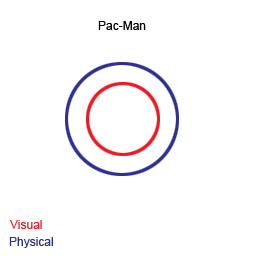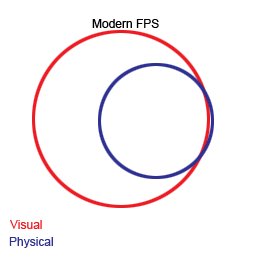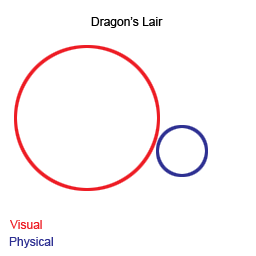Duality of Visual and Physical Realities in Game Designs
or, 'the rings theory'
When I've taught people about the fundamentals of game programming, I've noticed myself explaining how games have separate "physics" and "visual" sides. This is becomes very evident when doing fixed timestep physics, where physics are run, on average, a predetermined times per second, which doesn't need to have anything to do with the visual framerate.
I'm talking about physics even if there's no real "physics" involved. Even pac-man has physics of it's own. The physics is where the actual game happens, and what we've shown doesn't neccessarily have much to do with it.
So, I started thinking of how to represent this theory visually, to explain it further.


In pac-man, the visual and physical worlds are extremely in sync, and there's more to the physical world than there is to the visual, due to the limitations of the devices back then. Everything you see on the screen is somehow linked to the game pretty directly. There may be some forces in effect that do not have a direct visual representation, like the fact that each of the ghosts has its own, unique AI code.
In modern games, the visual and physical world differ intentionally. Due to the huge amounts of polygons on the visual side, there's often separate, simplified collision geometry.


If you look at a modern FPS, the visual side is much richer, and lots of things you can see have no relation to the physical world whatsoever - like most of the particle effects, glossy surfaces, etc.
There is often also some slight differences between the physical and the visual worlds (apart from the poly counts), including but not in any way limited to transparent walls that stop player from exploring outside the desired map area.
What really got me thinking about this "ring theory" was dragon's lair.


I started thinking about why dragon's lair is such a bad game, and I think the reason is what you can see in the third picture: the visual world has pretty much nothing to do with the physical world.
Dragon's lair, as a game, is much like a combination lock, do a mistake and you're dead. Often visuals even fool you to do the wrong thing. As an example, there's a room where the floor is crumbling, and you have two doorways to pick from. Picking either will kill you. The right way to go is to move towards a wall, where the knight moves a bench aside to reveal the correct way.
I hope this little theory proves to be an useful tool in analysing games.
Comments are appreciated.